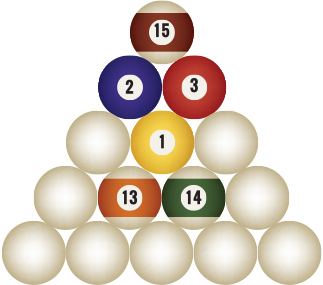American rotation, abbreviated AR or AmRo, is a pool (pocket billiards) game. It is a modern, tournament-oriented, call-pocket, call-safe variation on traditional rotation pool (or 61), devised to increase the degree of difficulty of the sport. It is the "flagship game" of the American Billiard Club (ABC), a division of CueSports International (CSI). The game was established by US professional pool player and instructor Joe Tucker in February 2013, and is contested in a pro–am American Rotation Championship Series of tournaments, with national championship held several times annually at varying locations.
The object of the sport is to score 100, 125 or 140 points, depending on the format and agreed-upon winning point score. Matches usually last between 8 and 15 racks, and take 90 minutes or longer to complete.
It is an accumulated-points game. Balls numbered 1–10 have a point value of 1. Balls numbered 11-15 have a point value of 2. Each rack contains a total of 20 points.
A player wins by reaching a pre-determined score of 100, 125, or 140 points. (Scoring apps exists for both Android and iOS.)
All 15 standard, numbered object balls are racked in a pyramid formation, with the apex ball on the foot spot.
The balls are racked in a specific order: The 15 ball is at the apex; the 2 and 3 balls are directly behind the 15 ball (in either order); the 1 ball is in the center; the 13 and 14 balls are behind the 1 ball (in either order); and all other balls are placed in any remaining position. Pattern racking these remaining balls is also allowed. (See illustration.)
Players lag for the first break. Players then alternate breaks in successive racks during a match.
Players break their own racks.
Unlike in most games, a player has cue ball in-hand after the break (the breaking player, if the break was legal, the opponent if it was not).
Specialized break cues are permitted.
A player's cue ball must strike the lowest-numbered object ball remaining on the table (balls need not be pocketed in this order; combination shots are legal). The exceptions are the break shot, and the "free shot" after three consecutive fouls, as detailed below.
Called shots or called safeties are required; every shot must be one or the other.
Additional balls pocketed on the same shot as the called shot are scored to the shooter.
If a player misses a called shot, the incoming player may pass (i.e., require the original shooter to continue shooting another called shot or safety).
If uncalled balls were pocketed on the missed called shot, they are credited to the player that takes the next shot.
These two passing and credit-to-next-shooter rules also apply if balls were pocketed during a called safety.
The incoming player has ball-in-hand after an opponent's foul.
Fouls are as defined as in the BCAPL "cue ball fouls only" rules, except that if any stationary ball is improperly disturbed, or the roll of any ball is interfered with, during the act of shooting, it is a foul (disturbed balls are not re-placed in such a case).
Balls pocketed on a foul remain pocketed, and are scored to the shooter's opponent.
After three consecutive fouls (not including a foul break) by an opponent, the incoming player receives two consecutive balls-in-hand. The first is a "free shot" in which: a) call-shot is not required; b) striking an object ball other than the lowest-numbered is not a foul; c) scratching the cue ball into a pocket is not a foul; d) and any balls pocketed on the free shot are scored to that shooter. Absent any foul on the free shot, the second ball-in-hand shot is played as any other ball-in-hand, with normal rules applicable. If a foul occurred on the "free shot", the player receives no second ball-in-hand, and the opponent receives ball-in-hand and credit for any balls pocketed on the foul, as with any other foul. Either player reaching three consecutive fouls, or the last ball of the rack being pocketed, resets both players' foul counts to zero.
Specialized or partial cues are not permitted for jump shots, which must be executed with the same playing cue used throughout the game.
The official rule book, Guidelines for American Rotation, is available from the American Billiard Club website.
The American Rotation Championship Series ("the ARCS" for short), is a three-staged cycle of player qualifications that culminates in a national championship. The cycle repeats six times annually. Entry into the national championship is dependent upon performance at the regional qualifier tournaments.
American rotation is included in professor and pool author/columnist David G. Alciatore's pool resources site. Matches are streamed live over the Internet at the news and entertainment site AZBilliards. Previous championship matches have also been streamed via InsidePool.tv.
Tom Simpson, from the National Billiard Academy, discusses why luck is a small factor in American rotation.

